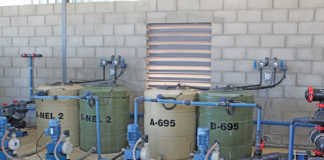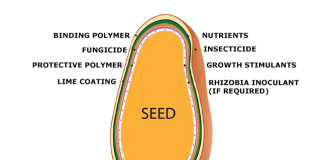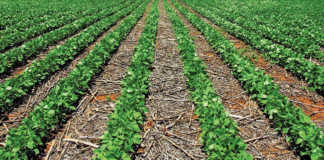The idea that leafroll virus has no impact on vineyards and might even help to improve wine quality is starting to evaporate as mounting evidence suggests the opposite. It is true that the virus does not destroy grapevines. It does, however, affect production and has been associated with crop losses of up to 60% in severe infections.
Leafroll also has a definite impact on wine quality, as the virus affects metabolic processes. This in turn leads to late ripening and to unbalanced fruit that are inferior in terms of sugar content, colour and wine flavour to grapes from healthy vines. A holistic approach is needed to combat the virus, since it can be transmitted through vegetative propagation and grafting with infected material.
The virus is not transmitted mechanically, for example by sap on pruning wounds, but by insect vectors such as mealybugs. Research by Prof Gerhard Pietersen of Citrus Research International indicates that the disease spreads relatively slowly, with an average infection rate of less than 5% per year in a range of 0,7% to 13%. Producers therefore have enough time to intervene if the disease is detected early. However, failure to react can allow the virus to spiral out of control and some farmers might have to remove entire vineyards.
One vineyard block investigated by Pietersen, which contained 11 939 plants, had only 487 infected vines (around 4% of the total) in 2001, and was left untreated. As a result the virus spread to infect almost half the vines in only four years. Using only certified virus-free rootstock and scion material when establishing new vineyards is one of the most important ways to prevent leafroll virus. Heat treatment and tissue culture of the nucleus plant are extremely effective in destroying the virus in cloned material. The problem arises if the vines are exposed to the disease when planted out. Another problem is that symptoms are not visible for a long time.
Producers might buy plant material that appears disease- free, only to find a few months later that it was infected. Pietersen is conducting research to establish the length of this latent period; his current studies suggest that it can take more than a year for symptoms to appear. There is a much lower risk of certified material having the virus because of stringent propagation and the high standards set for this type of plant material, according to Pietersen.
One of the ways in which nurseries are trying to maintain virusfree plant material is to develop more of the parent material in isolated areas or in areas far from traditional wine-producing regions.
Clean stock is expensive
Even though it greatly reduces the risk of infection, this practice is very expensive. “It costs almost R1,33 million annually to ensure that nucleus material, around 7 000 plants, complies with all the Vine Improvement Association’s specifications to be certified at KWV Vititec.
Developing plants from nucleus material in isolated or new areas also greatly increases transportation costs,” says Nico Spreeth of KWV Vititec. Johan Wiese from Voorgroen Nursery adds that nurserymen can be reluctant to stock plant material developed in this way because of the lower success rate and the increased cost of production. In addition, the market for this expensive plant material is quite limited even though there are more guarantees that it is free from leafroll virus. It is also more expensive for plant breeders to press grapes from these vines. Management, pruning and picking costs are also greatly increased because of the new challenges posed by unfamiliar production regions.
Plant breeders are creating cultivars that are more resistant to leafroll by using traditional breeding techniques and biotechnology. Such cultivars will greatly reduce production costs and allow producers to be more environmentally friendly, as they will be less dependent on chemicals to control vectors of the disease. Research is currently underway to ensure that South Africa does not fall behind in the use of this technology, but it will take years to release such a cultivar because of all the stringent tests it requires.
Distrust of GM vines
Jan Booysen, executive manager of Winetech, points out that the market, while demanding more environmentally friendly production, is not willing to buy wine produced from GM vines. This is currently the most promising way of producing resistant cultivars. While producers await the development of a leafroll-resistant cultivar, they will have to use some of the other strategies available to combat the spread of the virus. New vines should always be established in clean vineyards and monitored to ensure that they are leafroll-free, even if the plant material is certified, Pietersen explains.
Establishing new, certified high-quality (three-star) vines on new land is obviously the safest approach, but very few farmers still have the luxury of this option, says Pietersen. Mealybugs can survive on live grapevine material up to 60cm under the soil. Old vines should therefore be treated with a systemic insecticide before removal and producers should ensure that the entire vine is removed, root and all. Research on which herbicides are the most effective in destroying vines, is currently in progress.
Minimum vector-free period
Pietersen advises producers to leave a fallow period of at least one year between removing infected vines and planting new ones. Research is also being done to determine the minimum vector-free period needed to ensure that virus-carrying mealybugs are absent when new vines are established. Theoretically, it is only necessary to skip one generation of mealybugs to create a vector-free period. The new vines should be monitored over the next two seasons and any plant material exhibiting symptoms should be removed – root and all. Neighbouring plants should be treated with systemic insecticides to prevent the disease from spreading. These vines should also be monitored annually to establish whether they are infected. Any plants that have contracted the virus should be destroyed.
Mealybugs are extremely small and are easily dispersed by people moving from an infected to an uninfected vineyard. To prevent this, workers should be assigned to specific vineyards only or should work in healthy vineyards before moving to infected ones. Alternatively, workers must change clothes when moving between infected and uninfected vineyards. Farms that implement this method of control will need to establish a laundry facility. Pietersen advises that it is best to use more than one of these strategies. Farm implements and clothes should also be spray-cleaned or disinfected after use in infested vineyards.
To be on the safe side, producers directing farm traffic should assume that all white cultivars are infected with the virus, as it is very difficult to distinguish between healthy white cultivars and those that are infected. Read more on effective vector control in next week’s article. Contact Jan Booysen on (021) 807 3324 or e-mail [email protected].













